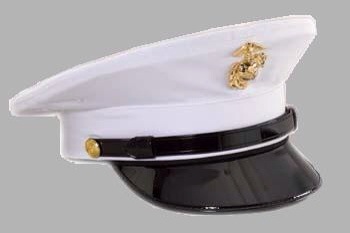Marine Covers And Church Ties
Sure, they’re real Marines, but their cover is all wrong.
What do you mean?
Your cover is supposed to be level with the deck. That guy in the middle and the the guy on the left are tipped too far back. The guy on the right is the only one wearing it correctly.
Hats. My friend William was talking about how Marines wear their hats.
 </a
</a
(Photo credit: USS Holland)
In one of our training rooms we have a mural that covers an entire wall. It shows a bunch of Marines in their dress blues standing in formation. Several of the Marines have their hats tipped too far back.
It’s a funny thing to notice, don’t you think? I mean, what difference does it matter how you wear your hat? Or if you even wear a hat. Did you know it is against the Military dress code for a soldier to be indoors with his hat on? Or outside without it on?
They military pays attention to those things. And they consider them very, very important. While the closest I ever got to the military was a semester with the ROTC, and a daughter who is an Army Reservist. But, I think there’s a reason for such strict adherence to a dress code.
Steve hated ties. Or maybe he just hated being told he had to wear one. Like some throwback to IBM of the 1950’s my company required all employees to wear white shirts and ties. Steve not only didn’t want to wear one, he wouldn’t.
The problem was Steve was a good engineer. So, what do you do? Do you make a big deal about something as simple as a tie? Do you write him up? If his manager made a big deal about it, Steve would simply tie a tie around his neck with a square knot and announce he was now compliant with the dress code.
I wasn’t Steve’s manager. So, I didn’t have to decide how to deal with him. His manager decided keeping a good employee was more important than a minor dress code violation.
Had I been Steve’s manager, there would have been no question. I would have fired him. Oh, I would have tried to coach him. But, if he refused to modify his behavior? He’s going to go, for two main reasons.
First, it’s a terrible example for other employees.
Why do we have to wear ties if Steve doesn’t?
People didn’t like the ties. Personally, I didn’t care. I’ve talked about Your Company Has a Uniform Even If It Doesn’t Have A Dress Code. I knew when I took the job that it came with a dress code, so did Steve. And, I’m not sure how I could have asked my other employees to make sacrifices like working long hours, or working extra on a project, or taking a trip over a holiday week, if I allowed Steve to skip on a tie.
The second reason I would have let Steve go is more important, and I think it is the same reason the military makes such a big deal about hats.
Most jobs require a level of attention to detail. Engineers who do sloppy work make unforced errors. Come on, Rodney, really? Not wearing a tie makes you a bad engineer? Not really. But, if you are not willing to follow the really simply dress guidelines, I’m not sure I can trust you to follow the required steps in a complex runbook.
If you think the dress rules don’t apply to you, how do I know you won’t cut corners because “protocols don’t apply to you?” If I can’t trust you to follow a rule where breaking it is very obvious, how do I know you’ll follow the rules when no one is watching?
How does this apply to the military and hats? I don’t think they really care about the rain. In fact, Marines refuse to carry an umbrella. (Seriously, carrying an umbrella is a violation of the dress code.) So, if they don’t really care about the purpose of a hat, why do they care about a hat? Because showing you will follow the little rules reassures people that you will follow the big ones.
So, it might seem extreme to fire a guy over refusing to wear a tie. But, think of it this way, would you fire an engineer that you couldn’t trust? So would I.
Rodney M Bliss is an author, columnist and IT Consultant. He lives in Pleasant Grove, UT with his lovely wife and thirteen children and one grandchild.
Follow him on
Twitter (@rodneymbliss)
Facebook (www.facebook.com/rbliss)
LinkedIn (www.LinkedIn.com/in/rbliss)
or email him at rbliss at msn dot com


Great article my friend, to which I would like to add my perspective. From a former Marine’s perspective (a) We don’t call them “hats” Marines refer to their headgear as a “cover”. (b) The Marines do train their troops to follow the letter of the law and the “brainwashing” process is amazing and quite thorough. 35 years later I still do things when and how I was taught by uncle Sam. I still roll out of bed “the rack” on November 10 (Marine Corps Birthday” and utter “ooorah”. I’m still attentive to military alignment (belt buckle, trouser zipper and shirt buttons) and to do otherwise is an atrocity. I put my dress trousers on after my shoes because using that order adds an extra shine to my shoes when pulled across my trousers and it also doesn’t wrinkle my trousers bending over to tie my shoes. I snap to attention at the national anthem and I show respect or the American Flag. And many others, too numerous to mention. Here is my point. If a platoon commander orders his men to do a particular task – there is no room for debate. The democratic process has no value (at this stage of the decision making continuum). And in deed could be a matter of life or death. In many military situations absolute compliance is often critical to completing the mission. In Corporate America – I doubt that a positive mission outcome will be determined by whether an individual was willing to adhere to the company dress code. The military demands it and for a good reason, corporate america….. not so much! Granted, today I am somewhat authority defiant and if the rules don’t make sense I find it difficult to offer blind adherence. Call it age, call it wisdom or call it what you will. If an employee refused to wear a tie, I would seriously evaluate the evaluate his or her value to the company. Perhaps it is time to “untie” the dress code and pitch the tie policy.
Tom